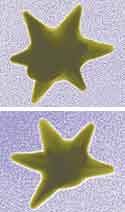Nanoworld Looks to the Stars for Imaging Secrets
January 1, 2009
R&D DIGEST
|
NIST scientists found that gold and silver nanostars improved the sensitivity of SERS. Color added for clarity. (Photo courtesy of NIST) |
Star-shaped nanoparticles are being tapped for biological sensing and imaging systems that could one day be used for disease diagnostics.
NIST scientists used surface-enhanced Raman spectroscopy (SERS) to demonstrate that gold nanostars exhibit optical qualities superior to any other nanoshape.
SERS uses metallic nanoparticles, commonly gold and silver, to amplify signals from trace molecules. In the experiment, the researchers shined laser light on an aqueous solution that contained the star-shaped nanoparticle and a molecule of interest. The characteristics of the molecule affect scattered light, forming a vibrational signature. The nanoparticles amplify that signature so that even very small concentrations of a molecule can be detected.
The researchers tested two target molecules in this experiment: 2–mercaptopyridine and crystal violet. Both were chosen for their structural similarities to biological molecules and their large number of delocalized electrons. The Raman signal of 2-mercaptopyridine was 100,000 times stronger when nanostars were present in the solution than when nanostars were removed, and the signal was 10 times stronger than when using nanorods.
NIST physicist Angela Hight Walker, PhD, and her team perfected the process of making the gold nanostars. They built the particles using surface alterations to manipulate growth and control shape. Once suspended in a solution, the team guided the nanostars to gather together to form multiple hot spots, where the enhancement is dramatically larger than for a single nanostar.
According to Hight Walker, these nanoshapes can be created en masse. Their desirable optical properties should prompt researchers to examine other possible applications.
Copyright ©2009 Medical Device & Diagnostic Industry
About the Author(s)
You May Also Like


.png?width=300&auto=webp&quality=80&disable=upscale)
